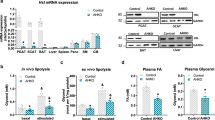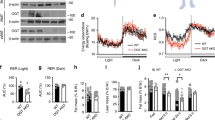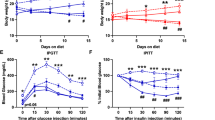Abstract
Obesity and type 2 diabetes mellitus are the major noncommunicable public health problem of the 21st century. The best strategy to tackle this problem is to develop strategies to prevent/treat obesity. However, it is becoming clear that despite successful research identifying weight regulatory pathways, the development of the obesity epidemic is outpacing scientific progress. The lack of success controlling the obesity epidemic in an aging population will result in another subsequent uncontrolled epidemic of complications. Our research focuses on the mechanisms causing lipotoxicity aiming to identify suitable strategies to prevent or at least retard the development of the metabolic syndrome. Previous work using transgenic and knockout mouse models has shown an interplay between white adipose tissue and skeletal muscle linking fatty acid (FA) synthesis with reciprocal effects on FA oxidation. Work from our lab and others suggests that defective adipose tissue is a key link between obesity, insulin resistance and type 2 diabetes mellitus by promoting the development of lipotoxicity in peripheral tissues. We propose a series of models to describe the process by which the adipose tissue could react to an energy-rich environment and responds depending on genetic and physiological factors, impacting on the functions of other peripheral tissues. We suggest that by examining hypotheses that encompass multiple organs and the partitioning of energy between these organs, a suitable strategy can be devised for the treatment of chronic obesity.
This is a preview of subscription content, access via your institution
Access options
Subscribe to this journal
Receive 12 print issues and online access
$259.00 per year
only $21.58 per issue
Buy this article
- Purchase on Springer Link
- Instant access to full article PDF
Prices may be subject to local taxes which are calculated during checkout



Similar content being viewed by others
References
Molina JM, Ciaraldi TP, Brady D, Olefsky JM . Decreased activation rate of insulin-stimulated glucose transport in adipocytes from obese subjects. Diabetes 1989; 38: 991–995.
Holm C, Osterlund T, Laurell H, Contreras JA . Molecular mechanisms regulating hormone-sensitive lipase and lipolysis. Annu Rev Nutr 2000; 20: 365–393.
Olefsky JM . Insensitivity of large rat adipocytes to the antilipolytic effects of insulin. J Lipid Res 1977; 18: 459–464.
Cases S, Smith SJ, Zheng YW, Myers HM, Lear SR, Sande E, Novak S, Collins C, Welch CB, Lusis AJ, Erickson SK, Farese Jr RV . Identification of a gene encoding an acyl CoA:diacylglycerol acyltransferase, a key enzyme in triacylglycerol synthesis. Proc. Natl Acad Sci USA 1998; 95: 13018–13023.
Smith SJ, Cases S, Jensen DR, Chen HC, Sande E, Tow B, Sanan DA, Raber J, Eckel RH, Farese Jr RV . Obesity resistance and multiple mechanisms of triglyceride synthesis in mice lacking Dgat [see comment]. Nat Genet 2000; 25: 87–90.
Abu-Elheiga L, Matzuk MM, Abo-Hashema KA, Wakil SJ . Continuous fatty acid oxidation and reduced fat storage in mice lacking acetyl-CoA carboxylase 2. Science 2001; 291: 2613–2616.
Kerner J, Hoppel C . Fatty acid import into mitochondria. Biochim Biophys Acta 2000; 1486: 1–17.
Wang S, Subramaniam A, Cawthorne MA, Clapham JC . Increased fatty acid oxidation in transgenic mice overexpressing UCP3 in skeletal muscle. Diabetes Obesity etab 2003; 5: 295–301.
Garg A . Lipodystrophies. Am J Med 2000; 108: 143–152.
Hotamisligil GS, Arner P, Caro JF, Atkinson RL, Spiegelman BM . Increased adipose tissue expression of tumor necrosis factor-alpha in human obesity and insulin resistance. J Clin Invest 1995; 95: 2409–2415.
Okuno A, Tamemoto H, Tobe K, Ueki K, Mori Y, Iwamoto K, Umesono K, Akanuma Y, Fujiwara T, Horikoshi H, Yazaki Y, Kadowaki T . Troglitazone increases the number of small adipocytes without the change of white adipose tissue mass in obese Zucker rats. J Clin Invest 1998; 101: 1354–1361.
Unger RH . Lipotoxic diseases. Annu Rev Med 2002; 53: 319–336.
Jequier E . Leptin signaling, adiposity, and energy balance. Ann NY Acad Sci 2002; 967: 379–388.
Sethi JK, Hotamisligil GS . The role of TNF alpha in adipocyte metabolism. Semin Cell Dev Biol 1999; 10: 19–29.
Yamauchi T, Kamon J, Waki H, Terauchi Y, Kubota N, Hara K, Mori Y, Ide T, Murakami K, Tsuboyama-Kasaoka N, Ezaki O, Akanuma Y, Gavrilova O, Vinson C, Reitman ML, Kagechika H, Shudo K, Yoda M, Nakano Y, Tobe K, Nagai R, Kimura S, Tomita M, Froguel P, Kadowaki T . The fat-derived hormone adiponectin reverses insulin resistance associated with both lipoatrophy and obesity. Nat Med 2001; 7: 941–946.
Arner P . The adipocyte in insulin resistance: key molecules and the impact of the thiazolidinediones. Trends Endocrinol Metab 2003; 14: 137–145.
Yokoyama C, Wang X, Briggs MR, Admon A, Wu J, Hua X, Goldstein JL, Brown MS . SREBP-1, a basic-helix–loop–helix-leucine zipper protein that controls transcription of the low density lipoprotein receptor gene. Cell 1993; 75: 187–197.
Tontonoz P, Kim JB, Graves RA, Spiegelman BM . ADD1: a novel helix–loop–helix transcription factor associated with adipocyte determination and differentiation. Mol Cell Biol 1993; 13: 4753–4759.
Brown MS, Goldstein JL . A proteolytic pathway that controls the cholesterol content of membranes, cells, and blood. Proc Natl Acad Sci USA 1999; 96: 11041–11048.
Kim JB, Spotts GD, Halvorsen YD, Shih HM, Ellenberger T, Towle HC, Spiegelman BM . Dual DNA binding specificity of ADD1/SREBP1 controlled by a single amino acid in the basic helix–loop–helix domain. Mol Cell Biol 1995; 15: 2582–2588.
Shimomura I, Shimano H, Horton JD, Goldstein JL, Brown MS . Differential expression of exons 1a and 1c in mRNAs for sterol regulatory element binding protein-1 in human and mouse organs and cultured cells. J Clin Invest 1997; 99: 838–845.
Shimano H, Horton JD, Shimomura I, Hammer RE, Brown MS, Goldstein JL . Isoform 1c of sterol regulatory element binding protein is less active than isoform 1a in livers of transgenic mice and in cultured cells. J Clin Invest 1997; 99: 846–854.
Ducluzeau PH, Perretti N, Laville M, Andreelli F, Vega N, Riou JP, Vidal H . Regulation by insulin of gene expression in human skeletal muscle and adipose tissue. Evidence for specific defects in type 2 diabetes. Diabetes 2001; 50: 1134–1142.
Hua X, Wu J, Goldstein JL, Brown MS, Hobbs HH . Structure of the human gene encoding sterol regulatory element binding protein-1 (SREBF1) and localization of SREBF1 and SREBF2 to chromosomes 17p11.2 and 22q13. Genomics 1995; 25: 667–673.
Horton JD, Goldstein JL, Brown MS . SREBPs: activators of the complete program of cholesterol and fatty acid synthesis in the liver. J Clin Invest 2002; 109: 1125–1131.
Sakai J, Nohturfft A, Cheng D, Ho YK, Brown MS, Goldstein JL . Identification of complexes between the COOH-terminal domains of sterol regulatory element-binding proteins (SREBPs) and SREBP cleavage-activating protein. J Biol Chem 1997; 272: 20213–20221.
Nohturfft A, Yabe D, Goldstein JL, Brown MS, Espenshade PJ . Regulated step in cholesterol feedback localized to budding of SCAP from ER membranes. Cell 2000; 102: 315–323.
Brown AJ, Sun L, Feramisco JD, Brown MS, Goldstein JL . Cholesterol addition to ER membranes alters conformation of SCAP, the SREBP escort protein that regulates cholesterol metabolism. Mol Cell 2002; 10: 237–245.
Espenshade PJ, Li WP, Yabe D . Sterols block binding of COPII proteins to SCAP, thereby controlling SCAP sorting in ER. Proc Natl Acad Sci USA 2002; 99: 11694–11699.
Brown MS, Goldstein JL . The SREBP pathway: regulation of cholesterol metabolism by proteolysis of a membrane-bound transcription factor. Cell 1997; 89: 331–340.
Yang T, Espenshade PJ, Wright ME, Yabe D, Gong Y, Aebersold R, Goldstein JL, Brown MS . Crucial step in cholesterol homeostasis: sterols promote binding of SCAP to INSIG-1, a membrane protein that facilitates retention of SREBPs in ER. Cell 2002; 110: 489–500.
Yabe D, Brown MS, Goldstein JL . Insig-2, a second endoplasmic reticulum protein that binds SCAP and blocks export of sterol regulatory element-binding proteins. Proc Natl Acad Sci USA 2002; 99: 12753–12758.
Kim JB, Sarraf P, Wright M, Yao KM, Mueller E, Solanes G, Lowell BB, Spiegelman BM . Nutritional and insulin regulation of fatty acid synthetase and leptin gene expression through ADD1/SREBP1. J Clin Invest 1998; 101: 1–9.
Le Lay S, Lefrere I, Trautwein C, Dugail I, Krief S . Insulin and sterol-regulatory element-binding protein-1c (SREBP-1C) regulation of gene expression in 3T3-L1 adipocytes. Identification of CCAAT/enhancer-binding protein beta as an SREBP-1C target. J Biol Chem 2002; 277: 35625–35634.
Sewter C, Berger D, Considine RV, Medina G, Rochford J, Ciaraldi T, Henry R, Dohm L, Flier JS, O’Rahilly S, Vidal-Puig AJ . Human obesity and type 2 diabetes are associated with alterations in SREBP1 isoform expression that are reproduced ex vivo by tumor necrosis factor-alpha. Diabetes 2002; 51: 1035–1041.
Ricquier D, Bouillaud F . The uncoupling protein homologues: UCP1, UCP2, UCP3, StUCP and AtUCP. Biochem J 2000; 345 (Part 2): 161–179.
Rosenberg D, Groussin L, Jullian E, Perlemoine K, Bertagna X, Bertherat J . Role of the PKA-regulated transcription factor CREB in development and tumorigenesis of endocrine tissues. Ann NY Acad Sci 2002; 968: 65–74.
Canettieri G, Celi FS, Baccheschi G, Salvatori L, Andreoli M, Centanni M . Isolation of human type 2 deiodinase gene promoter and characterization of a functional cyclic adenosine monophosphate response element. Endocrinology 2000; 141: 1804–1813.
Herzig S, Long F, Jhala US, Hedrick S, Quinn R, Bauer A, Rudolph D, Schutz G, Yoon C, Puigserver P, Spiegelman B, Montminy M . CREB regulates hepatic gluconeogenesis through the coactivator PGC-1. Nature 2001; 413: 179–183.
Weitzel JM, Iwen KA, Seitz HJ . Regulation of mitochondrial biogenesis by thyroid hormone. Exp Physiol 2003; 88: 121–128.
Wu Z, Puigserver P, Andersson U, Zhang C, Adelmant G, Mootha V, Troy A, Cinti S, Lowell B, Scarpulla RC, Spiegelman BM . Mechanisms controlling mitochondrial biogenesis and respiration through the thermogenic coactivator PGC-1. Cell 1999; 98: 115–124.
Tiraby C, Tavernier G, Lefort C, Larrouy D, Bouillaud F, Ricquier D, Langin D . Acquirement of brown fat cell features by human white adipocytes. J Biol Chem 2003; 278: 33370–33376.
Lin J, Wu H, Tarr PT, Zhang CY, Wu Z, Boss O, Michael LF, Puigserver P, Isotani E, Olson EN, Lowell BB, Bassel-Duby R, Spiegelman BM . Transcriptional co-activator PGC-1 alpha drives the formation of slow-twitch muscle fibres [see comment]. Nature 2002; 418: 797–801.
Lin J, Puigserver P, Donovan J, Tarr P, Spiegelman BM . Peroxisome proliferator-activated receptor gamma coactivator 1beta (PGC-1beta), a novel PGC-1-related transcription coactivator associated with host cell factor. J Biol Chem 2002; 277: 1645–1648.
Meirhaeghe A, Crowley V, Lenaghan C, Lelliott C, Green K, Stewart A, Hart K, Schinner S, Sethi JK, Yeo G, Brand MD, Cortright RN, O’Rahilly S, Montague C, Vidal-Puig AJ . Characterization of the human, mouse and rat PGC1 beta (peroxisome-proliferator-activated receptor-gamma co-activator 1 beta) gene in vitro and in vivo. Biochem J 2003; 373: 155–165.
St-Pierre J, Lin J, Krauss S, Tarr PT, Yang R, Newgard CB, Spiegelman BM . Bioenergetic analysis of peroxisome proliferator-activated receptor gamma coactivators 1alpha and 1beta (PGC-1alpha and PGC-1beta) in muscle cells. J Biol Chem 2003; 278: 26597–26603.
Author information
Authors and Affiliations
Corresponding author
Rights and permissions
About this article
Cite this article
Lelliott, C., Vidal-Puig, A. Lipotoxicity, an imbalance between lipogenesis de novo and fatty acid oxidation. Int J Obes 28 (Suppl 4), S22–S28 (2004). https://doi.org/10.1038/sj.ijo.0802854
Published:
Issue Date:
DOI: https://doi.org/10.1038/sj.ijo.0802854
Keywords
This article is cited by
-
Effects of maternal cigarette smoke exposure on the progression of nonalcoholic steatohepatitis in offspring mice
Toxicological Research (2023)
-
Use of human PBMC to analyse the impact of obesity on lipid metabolism and metabolic status: a proof-of-concept pilot study
Scientific Reports (2021)
-
High-Risk Groups for Non-alcoholic Fatty Liver and Non-alcoholic Steatohepatitis Development and Progression
Current Hepatology Reports (2020)
-
Metabolic syndrome: an update on diagnostic criteria, pathogenesis, and genetic links
Hormones (2018)
-
Association of plasma fatty acid alteration with the severity of coronary artery disease lesions in Tunisian patients
Lipids in Health and Disease (2017)



